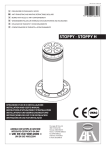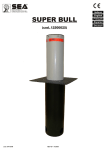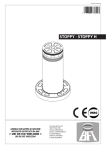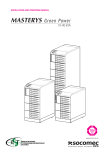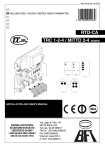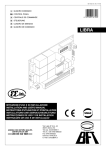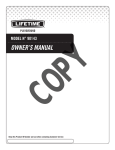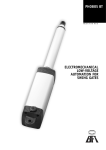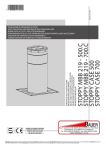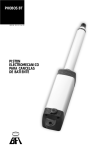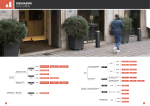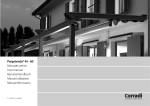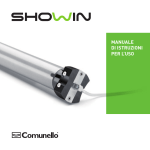Download STOPPY - STOPPY H
Transcript
D811319 ver. 10 30-01-09 I DISSUASORE DI PASSAGGIO E SOSTA GB ANTI-TRANSITING AND WAITING RETRACTABLE BOLLARD 8 F BORNE ANTI-ACCES ET ANTI-STATIONNEMENT D VERSENKBARER POLLER ZUR SPERRUNG VON DURCHFAHRTEN UND HALTEZONEN E DISUASOR DE TRANSITO Y ESTACIONAMIENTO P CONDICIONADOR DE TRÂNSITO e ESTACIONAMENTO 027908 186416 STOPPY - STOPPY H ISTRUZIONI D’USO E DI INSTALLAZIONE INSTALLATION AND USER’S MANUAL INSTRUCTIONS D’UTILISATION ET D’INSTALLATION INSTALLATIONS-UND GEBRAUCHSANLEITUNG INSTRUCCIONES DE USO Y DE INSTALACION INSTRUÇÕES DE USO E DE INSTALAÇÃO Via Lago di Vico, 44 36015 Schio (VI) Tel.naz. 0445 696511 Tel.int. +39 0445 696533 Fax 0445 696522 Internet: www.bft.it E-mail: [email protected] D811319_10 2 - STOPPY - Ver. 10 USER’S MANUAL Thank you for buying this product, our company is sure that you will be more than satisfied with its performance. This product is supplied with a “Warnings” leaflet and an “Instruction Manual”. These should both be read carefully as they provide important information about safety, installation, operation and maintenance. This product complies with recognised technical standards and safety regulations. We declare that it is in conformity with the following European Directives: 2004/108/EEC, 2006/108/EEC, 98/37/EEC (and subsequent amendments). any damage caused by failure to observe the installation standards, good technical practice standards and directives specified in the present manual. The descriptions and illustrations contained in the present manual are not binding. The Company reserves the right to make any alterations deemed appropriate for the technical, manufacturing and commercial improvement of the product at any time, while leaving the essential product features unchanged. 1) GENERAL OUTLINE Underground anti-waiting bollard, compact and sturdy. It consists of a steel rod coated with reflecting material, and powered by an oil-bath motor; all protected by a hot-galvanised steel cylinder which is fitted underground. The PERSEO N control panel allows up to four bollards to be controlled simultaneously. Besides the standard version, STOPPY is available in the following models: “L” series provided with signal indication blinker lights and, on request, “R” series provided with a heated resistor which also allows the bollard to be used in particularly cold climates (as much as –25°C) and “A” series provided with a magnetic sensor for connection to an antitheft system. Accessories: Electric brake buffer battery kit, which allows the bollard to be kept in the access closed position even when the mains power is off. 2) SAFETY If correctly installed and used, this automation device satisfies the required safety level standards. However, it is advisable to observe some practical rules in order to avoid accidental problems. Before using the automation device, carefully read the operation instructions and keep them for future reference. t ,FFQDIJMESFOQFSTPOTBOEUIJOHTPVUTJEFUIFBVUPNBUJPOXPSLJOH range, particularly during operation. t ,FFQSBEJPDPOUSPMTPSPUIFSDPOUSPMEFWJDFTPVUPGDIJMESFOTSFBDI in order to avoid any unintentional automation activation. t %POPUJOUFOUJPOBMMZPQQPTFUIFSPENPWFNFOU t %POPUNPEJGZUIFBVUPNBUJPODPNQPOFOUT t *ODBTFPGNBMGVODUJPOBDUJWBUFUIFDVUPVUTXJUDIFTUPEJTDPOOFDU the power supply, batteries included, in order to gain access to the automation device, and request the assistance of a qualified person (installer). t #FGPSFQSPDFFEJOHUPBOZFYUFSOBMDMFBOJOHPQFSBUJPOBDUJWBUFUIF cut-out switches to disconnect the mains powers supply and the batteries, if provided. t ,FFQUIFQIPUPDFMMPQUJDBMDPNQPOFOUTBOEMJHIUTJHOBMEFWJDFTDMFBO Check that none of the safety devices (photocells) are obscured by branches or shrubs. t 'PSBOZEJSFDUBTTJTUBODFUPUIFBVUPNBUJPOTZTUFNSFRVFTUUIFIFMQ of a qualified person (installer). t )BWF RVBMJöFE QFSTPOOFM JOTQFDU UIF BVUPNBUJPO TZTUFN PODF B year. 3) MANUAL MANOEUVRE When the power supply is disconnected, the bollard tends to lower spontaneously, therefore carrying out an opening manoeuvre; a simple pressure exerted on the top of the cylinder surface will complete lowering, and vehicle transit will be allowed. See fig. 1. N.B. opening means bollard lowered (transit allowed), closing means bollard raised (transit not allowed) In the case of bollards provided with buffer batteries, before proceeding to manual manoeuvre, disconnect the emergency power supply by means of the appropriate switch fitted by the installer. 4) MAINTENANCE AND SCRAPPING System maintenance is to be regularly carried out by qualified personnel. The materials making up the appliance and its packing are to be scrapped according to current standards. Batteries must be disposed of in the appropriate manner. WARNING Correct operation of the controller is only guaranteed when the data specified in this manual are respected, as well as good technical practice standards. The Company cannot be held responsible for 4 - STOPPY - Ver. 10 Fig. 1 D811319_10 ENGLISH INSTALLATION MANUAL Thank you for buying this product, our company is sure that you will be more than satisfied with its performance. This product is supplied with a “Warnings” leaflet and an “Instruction Manual”. These should both be read carefully as they provide important information about safety, installation, operation and maintenance. This product complies with recognised technical standards and safety regulations. We declare that it is in conformity with the following European Directives: 2004/108/ EEC, 2006/108/EEC, 98/37/EEC (and subsequent amendments). 1) GENERAL SAFETY WARNING! An incorrect installation or improper use of the product can cause damage to persons, animals or things. The Company declines all responsibility for any consequences resulting from improper use of the product, or use which is different from that expected and specified in the present documentation. t 5IFi8BSOJOHTwMFBøFUBOEi*OTUSVDUJPOCPPLMFUwTVQQMJFEXJUIUIJTQSPEVDU should be read carefully as they provide important information about safety, installation, use and maintenance. t 4DSBQQBDLJOHNBUFSJBMTQMBTUJDDBSECPBSEQPMZTUZSFOFFUD BDDPSEJOHUPUIF provisions set out by current standards. Keep nylon or polystyrene bags out of children’s reach. t ,FFQUIFTFJOTUBMMBUJPOJOTUSVDUJPOTUPHFUIFSXJUIUIFUFDIOJDBMCSPDIVSFGPS future reference. t 5IJTQSPEVDUXBTFYDMVTJWFMZEFTJHOFEBOENBOVGBDUVSFEGPSUIFVTFTQFDJöFE in the present documentation. Any other use not specified in this documentation could damage the product and be dangerous. The Company declines all responsibility for any consequences resulting from improper use of the product, or use which is different from that expected and specified in the present documentation. t %POPUJOTUBMMUIFQSPEVDUJOQPUFOUJBMMZFYQMPTJWFBUNPTQIFSFPSXIFSFWFS there is a fire risk. t 5IFDPOTUSVDUJPODPNQPOFOUTPGUIJTQSPEVDUNVTUDPNQMZXJUIUIFGPMMPXJOH European Directives: 2004/108/CEE, 2006/108/EEC, 98/37 EEC and subsequent amendments. As for all non-EEC countries, the above-mentioned standards as well as the current national standards should be respected in order to achieve a good safety level. t 5IF$PNQBOZEFDMJOFTBMMSFTQPOTJCJMJUZGPSBOZDPOTFRVFODFTSFTVMUJOHGSPN failure to observe Good Technical Practice when installing the device described in the present manual. t 5IF JOTUBMMBUJPO NVTU DPNQMZ XJUI UIF QSPWJTJPOT TFU PVU CZ UIF GPMMPXJOH European Directives: 2004/108/CEE, 2006/108/EEC, 98/37 EEC and subsequent amendments. t %JTDPOOFDUUIFFMFDUSJDBMTVQQMZCFGPSFDBSSZJOHPVUBOZXPSLPOUIFJOTUBMlation. Also disconnect any buffer batteries, if fitted. t 'JUBOPNOJQPMBSPSNBHOFUPUIFSNBMTXJUDIPOUIFNBJOTQPXFSTVQQMZIBWing a contact opening distance equal to or greater than 3,5 mm. Also fit an adequate cut-out device for the buffer batteries. t $IFDLUIBUBEJòFSFOUJBMTXJUDIXJUIB"UISFTIPMEJTöUUFEKVTUCFGPSFUIF power supply mains. t $IFDLUIBUFBSUIJOHJTDBSSJFEPVUDPSSFDUMZDPOOFDUBMMNFUBMQBSUTPGUIFDMPTJOH mechanism and all system components provided with an earth terminal. t 'JUBMMUIFTBGFUZEFWJDFTQIPUPDFMMTFMFDUSJDFEHFTFUD XIJDIBSFOFFEFE to protect the area from any danger caused by squashing, conveying and shearing. t 1PTJUJPOBUMFBTUPOFMVNJOPVTTJHOBMJOEJDBUJPOEFWJDFCMJOLFS XIFSFJUDBO be easily seen, and fix a Warning sign next to the structure. t 5IF$PNQBOZEFDMJOFTBMMSFTQPOTJCJMJUZXJUISFTQFDUUPUIFBVUPNBUJPOTBGFUZ and correct operation when other producers’ components are used. t 0OMZVTFPSJHJOBMQBSUTGPSBOZNBJOUFOBODFPSSFQBJSPQFSBUJPO t %POPUNPEJGZUIFBVUPNBUJPODPNQPOFOUTVOMFTTFYQMJDJUMZBVUIPSJTFECZ the Company. t *OTUSVDUUIFQSPEVDUVTFSBCPVUUIFDPOUSPMTZTUFNTQSPWJEFEBOEUIFNBOVBM opening operation in case of emergency. t Do not allow persons or children to remain within the automation operation area. t ,FFQSBEJPDPOUSPMPSPUIFSDPOUSPMEFWJDFTPVUPGDIJMESFOTSFBDIJOPSEFSUP avoid unintentional automation activation. t 5IFVTFSNVTUBWPJEBOZBUUFNQUUPDBSSZPVUXPSLPSSFQBJSPOUIFBVUPNBUJPO system, and always request the assistance of qualified personnel. t "OZUIJOHXIJDIJTOPUFYQSFTTMZQSPWJEFEGPSJOUIFQSFTFOUJOTUSVDUJPOTJT not allowed. t *OTUBMMBUJPONVTUCFDBSSJFEPVUVTJOHUIFTBGFUZEFWJDFTBOEDPOUSPMTQSFTDSJCFE by the EN 12978 Standard. 2) GENERAL OUTLINE Underground anti-waiting bollard, compact and sturdy. It consists of a steel rod coated with reflecting material, and powered by an oil-bath motor; all protected by a hot-galvanised steel cylinder which is fitted underground. The PERSEO N control panel allows up to four bollards to be controlled simultaneously (Fig.8). 12 - STOPPY - Ver. 10 Besides the standard version, STOPPY is available in the following models:“L”series provided with signal indication blinker lights and, on request, “R” series provided with a heated resistor which also allows the bollard to be used in particularly cold climates (as much as –25°C) and “A” series provided with a magnetic sensor for connection to an antitheft system. Accessories: Electric brake buffer battery kit, which allows the bollard to be kept in the access closed position even when the mains power is off. 3) TECHNICAL SPECIFICATIONS FOR STOPPY ACTUATOR Motor: ................................................................................................. 230V~ ±10% 50/60 Hz* Capacitor: ..............................................................................................................................10 μF Power input .........................................................................................................................270 W Limit switch ..........................................................................................magnetic reed sensor Absorption: .....................................................................................1.4 A (230V) 2.4 A (110V) Work frequency:..........................................................................................................1500/24h Maximum torque:.............................................................................................700 N (~70 kg) Degree of protection:.......................................................................................................... IP67 Control panel .............................................................................................................. PERSEO N Electric brake:....................................................................................................................24V Working time: ............................................................................................... 6s+slow-down** Working temperature ........................................................................................–15°C + 60°C Working temperature for “R” versions .........................................................–25°C + 60°C Front impact resistance on rod raised by 350 mm: ................................... 8,000 Joule (50% breakagepossibility) Static Load: ........................................Max. sustainable weight with raised rod: 300kg Max. sustainable weight with lowered rod: 15,000 kg Dynamic Load: ............................................................................. Max. raising force : 100kg Weight: ...................................................................................................................... 90 kg ca.*** Dimensions : .................................................................................................................. see fig. 1 Manual manoeuvre: ..........................When the current is off, it becomes reversible. (* other voltages available on request) (** 9s+slow-down STOPPY H) (*** 110 kg ca. STOPPY H) 4) TECHNICAL SPECIFICATIONS FOR PERSEO N CONTROL PANEL Power supply: .................................................................................. 230V~ ±10% 50/60Hz* Absorbed current: ....................................................................... 6A max (with 4 bollards) Maximum no. of motors: ........................................... up to 4 STOPPY bollards (Fig.8) Dimensions: .............................................................................................................see figure 4 Fuses: ..................................................................................F2: T315 mA / F3: T2A / F4: T2A (* other voltages available on request) WARNING! The 100V 50 and 60Hz control units can control two anti-transiting bollards in parallel only, instead of four. 5) PRELIMINARY CHECKS Check that the installation base is stable and level. For correct operation, the bollard does not require precise verticality; however, to obtain a good aesthetic result, it is advisable to proceed to levelling the installation area so as to ensure that the rod stroke is perfectly vertical. 6) FOUNDATION DIGGING AND BOLLARD POSITIONING t 1SPDFFEBTTIPXOJOöH t $BSSZPVUFMFDUSJDBMJOTUBMMBUJPOTFFQBSBHSBQI 7) ELECTRICAL INSTALLATION SET-UP Lay out the electrical installation as shown in fig. 3, making reference to the current CEI 64-8, IEC 364 (HD 384 harmonised) electrical standards, and other national standards. WARNING! For connection of the control panel to the mains, use a multicolour cable having a minimum 3x1.5 sq mm cross section of the type set out by the current standards. For example, if the cable is installed outside (in the open air), it must be at least equal to H07RN-F, whereas, if it is installed inside (in a raceway), it must be at least equal to H05 VV-F and have a 3x1.5 sq mm cross section. To connect the bollard to the control panel, use cable supplied as standard and already wired inside the bollard. Should the cable be too short, join it inside a watertight box, using two separate cables for low voltage and mains voltage connections. Particular attention must be paid in separating and fixing the wiring, so that the low voltage and mains voltage cables are prevented from coming into contact. Connect the control and safety devices in compliance with the installation technical standards mentioned previously. Fig. 3 shows the number of connections and their cross section for an approximate length of 100 metres: in case of longer cables, calculate the cross section for the true automation load. D811319_10 ENGLISH D811319_10 INSTALLATION MANUAL Example of installation: I Type-approved omnipolar circuit breaker, which must be adequately rated and have at least 3,5 mm contact opening, provided with protection against overloads and short circuits. If not already installed, place a type-approved differential switch with a 0.03A threshold just before the automation system. QR Control panel and incorporated receiver S Key selector AL Blinker with tuned antenna M Bollard P Wall-mounted pushbutton panel Fte, Fre Pair of photocells T 1-2-4 channel transmitter SF Red and green traffic lights SM Magnetic coil NOTE: The choice of the type and number of safety devices to be installed depends on the particular use and installation location. 8) TERMINAL BOARD CONNECTIONS Having passed adequate electric cables through the raceways, and fixed the various automation components in the chosen points, these must be connected according to the indications given in the diagrams below. Carry out connection of the phase, neutral and earth (compulsory) wires. The protection (earth) wire with yellow/green insulating sheath must be connected to the appropriate terminals marked by the earthing symbol. The automation system must only be commissioned after all the safety devices have been connected and inspected. Here follows the description of the PERSEO N mod. control unit supplied as standard (fig. 4). CN1 1-2 Single-phase mains supply (1=L) (2=N) 3-4-5 Motor connection (3 opening - black wire, 4 common - blue wire, 5 closing - brown wire) up to 4 motors in parallel N.B. opening means bollard lowered (transit allowed), closing means bollard raised (transit not allowed) 6-7-8 Traffic light output (6 green, 8 red, 7 common) 230V 25+25W max 9-10 Blinker output 230V CN2 11-12 Electric brake outputs 24V (up to 4 in parallel) white wires 13-14 Buffer battery board input at 12 Vd.c. to maintain electric brake with mains power off 15-16 STOPPY signalling LED outputs 24V~ (up to 4 in parallel) 0.8 A max yellow wires 17-18 AUX NO contact output timed from 2s to 120s 19-20 Supply to accessories 24 V~ 1 A max CN3 21-22 Photocell input (NC contact) active on closing 23-24 Stop command input (NC contact) - stops the manoeuvre and leaves the bollard released. A subsequent Start command always activates bollard opening, unless already opened, in which case it controls closing. 24-25 Opening limit switch input - green wires 26-29 Start command input (NO contact, 2-step logic: open-close) - with the bollard raised, the Start command initiates the lowering manoeuvre, during which this command is not active; with the bollard lowered, the Start command initiates the manoeuvre, and during rod raising, a new Start command interrupts the manoeuvre and controls lowering. 27-29 Open command input (NO contact) The contact “open” also acts as safety device in that, after the bollard has beeen lowered, it deactivates the closing and start command, interrupting also the automatic re-closing until it is released. 28-29 Close command input (NO contact) 30-31 CN4 Heating resistor Terminal preset for supplying the heating resistor (230V~100W max) on the “R” series models. Allows the bollard to be used even in particularly cold climates. However, even with the heating resistor installed, it may be necessary to remove any layers of ice which have formed on the bollard surface (red wires). 32-33 CN6 Antitheft device Presetting of reed sensor located on the flange of the “A” series bollard. Allows the bollard to be connected to an external antitheft device. In the case of an attempt to tamper with the bollard, the sensor activates the alarm system (orange wires, NC contact). CN8 Radio Receiver Connection for single and double-channel radio receiver The second channel is always connected to the close command (see dip-switch 5 configuration). The first channel can be configured, by means of the J1 jumper (see fig. 4), as: ENGLISH t 4UBSUXJUITUFQMPHJDPQFODMPTF see Start command description in the paragraph concerning terminal board connections. t 0QFO only accepts the opening command. To control closing and opening by means of two different keys on a doublechannel transmitter, use a double-channel receiver and move the J1 jumper on the PERSEO N control panel to the Open position. 34-35 CN9 Antenna Antenna input (35 signal, 34 braid). RG58 Cable. The components - Heating resistor (red cables), Electric brake (white cables), LED lights (yellow cables), Opening limit switches (green cables) and Antitheft contact (orange cables) - are not polarised, therefore the position of the cables of the same colour is interchangeable. 9) CONNECTION TO SEVERAL MOTORS Refer to Fig.8. for the connection to several motors. The motor capacitors must be connected in parallel. To do this, cut the CM connector of the capacitor and use an auxiliary external terminal board. The limit switches must be connected in series as indicated in Fig.8. The electric brakes must be connected in parallel as indicated in Fig.8. The connections must be completed in a workmanlike manner. DIP-SWITCH CONFIGURATION 1 T LAVORO LEAVE THE DIP1 OFF! 2 T PAUSA Enables subsequent automatic closing OFF= excluded ON= dwell time to be entered and set by means of appropriate trimmer (dwell time) from 2s to 120s 3 SET PAUSA Enables Start and Close commands during dwell time OFF= disabled ON= enabled 4 SET AP Start command only valid when activated after Open command OFF= independent inputs ON= restricted inputs 5 SET CH Closing command OFF= impulse activated ON= impulse released 6 PRELAMP Pre-blinking on blinker and traffic light OFF= excluded ON= 2s before each manoeuvre with alter nate green-red signal on the traffic light before each closing operation 7 LED OK AP Operation of LED lights with bollard raised OFF= fixed lights ON= blinking at 1s 8 LED OK CH Operation of LED lights with bollard lowered OFF= fixed lights ON= blinking at 0,5s J2 Device select OFF= STOPPY (50 cm) ON= STOPPY H (70 cm) TRIMMER SETTING T AUX Sets the Aux contact activation time from 2s to 120 s V RALL Sets the approaching speed towards the mechanical closing liminting device (on opening the slow-down is steady). TPAUSA Sets the dwell time from 2s to 120s. 10) CONCENTRICITY SETTING UP For correct operation, proceed to setting up the cylinder concentricity in order that, during the opening and closing manoeuvres, movement occurs smoothly, regularly and without oscillation. To set up the cylinder, proceed as follows: Use a no.4 Allen key to unscrew and remove dowels A (fig. 5). Insert a no.3 flathead screwdriver (DIN 0,8x5) and turn it one way or the other until obtaining concentricity (fig. 5). During this phase concentricity can be checked visually, making sure that the distance between the cylinder and external flange is as uniform as possible. Then proceed to a practical check, carrying out a few manoeuvres during which the cylinder movement can be checked. Screw the 4 dowels in tight. STOPPY- Ver. 10 - 13 INSTALLATION MANUAL WARNING! Concentricity is very important for the correct operation and life of the actuator; it is to be first calibrated during the installation phase, checked after 6 months and then every year. Operation with marked eccentricity could lead to deterioration of the rod seals. 11) DISASSEMBLY Should it be necessary to gain access to the bollard internal components or motor, refer to fig. 6 and proceed as follows: 1 Disconnect the electrical supply before carrying out any operation on the system. Also disconnect any buffer batteries, if fitted. 2 Use a no.6 Allen key to unscrew and remove 4 external screws A, and a no.4 Allen key to remove dowels B. 3 Remove external flange C. 4 Use special wrench D (supplied) to unscrew and remove central block E. 5 Use a no.13 socket spanner to unscrew and remove underlying nut F and respective washers. 6 At this point, use a small screwdriver as a lever on the junction between cylinder and cap to remove the upper part of cylinder G. 7 If the model is supplied with signal indication lights, these must be disconnected. Then unscrew piston pin H, and subsequently the Faston connections. 8 Take out cylinder I, using a cable or a hook passing through the upper cylinder holes. Do not place your hands in the upper holes to take out or put back the cylinder (the presence of centre pin L could cause injuries). Withdraw the signal light connection cable from the cylinder. 9 Withdraw 4 adjustment pins M from supports N, and then withdraw supports N from adjustment bracket O. 10 It is now possible to take out the entire motor unit and proceed to any inspections or repairs needed. 12) ASSEMBLY 1 Check that adjustment brackets O are completely screwed onto lower bracket P, in order that it might be easier to set up concentricity after assembly is completed. 2 Reposition the motor unit on the bottom of the cylinder, making sure that the cable is not squashed under the lower plate. For this purpose, we advise you to tie a wire to the cable to keep it raised during motor positioning; later you can proceed to arrange the exceeding cable under upper flange Q, so that it does not interfere with the rod stroke. Also check the alignment of adjustment pins M with reference to the holes in the cylinder, in order for positioning of flange C to take place without any problems. 3 Proceed to repositioning 4 supports N on the adjustment brackets, as well as adjustment pins M. 4 Insert cylinder I, using a cable or a hook passing through the upper cylinder holes. Do not place your hands in the upper holes to take out or put back the cylinder (the presence of central pin L could cause injuries). In the case of bollards supplied with signal lights, provide for the power supply cable to pass through (this operation can be made easier by tying a wire to the connection pin). Mechanical end-of-stroke R is fitted to the bottom of the cylinder; during re-assembly, the position of the end-of-stroke referred to sensor S must be respected. In the case of bollards provided with alarm sensors, pay attention to the position of magnet T fitted to the flange, which must coincide with the position of sensor U fixed to the cylinder. 5 Reconnect the light supply Faston connections and retighten piston pin H. The signal indication lights are not polarised, therefore the position of the contacts is irrelevant. 6 Reposition the upper part of cylinder G and fix nut F by means of a no.13 socket spanner. 7 Use special wrench D to screw central block E. 8 Use a no.6 Allen key to tighten 4 external screws A, and a no.4 Allen key to tighten dowels B. WARNING! After each disassembly and assembly operation, proceed to checking concentricity. 13) MANUAL MANOEUVRE When the power supply is disconnected, the bollard tends to lower spontaneously, therefore carrying out an opening manoeuvre; a simple pressure carried out on the top cylinder surface will complete lowering, and vehicle transit will be allowed. See fig. 7. To prevent the cylinder from lowering when the mains power is off, a buffer battery system is required. In this case, the installer must fit a battery cut-out switch, in order to allow manual manoeuvre to be carried out when the mains power is off. The installer undertakes to instruct the user on correct automation use, highlighting the operations to be carried out in case of emergency. 14 - STOPPY - Ver. 10 14) MALFUNCTIONS. CAUSES AND REMEDIES t *GUIFCPMMBSEEPFTOPUNPWFTNPPUIMZQSPDFFEUPTFUUJOHVQDPODFOUSJDJUZ (see paragraph 9). t *GUIFSPEEPFTOPUNPWFVQDIFDLUIBUUIFNBJOTQPXFSTVQQMZJTPOBOZ buffer batteries supplied are efficient, and the fuses are in good condition; also check the motor connections to the control panel. t *G UIF SPE EPFT OPU NPWF EPXO JU JT QSPCBCMF UIBU BO 0QFO DPNNBOE JT constantly given from the control panel or other external device. Therefore temporarily disconnect all the external devices in order to identify the cause of the problem. If the rod still remains raised, proceed to disconnecting the power supply and then checking the control panel. Anyway, when the power supply is off, the rod should spontaneously tend to lower; if this does not happen, proceed to disassembly (paragraph 10) in order to identify any mechanical problems preventing the lowering manoeuvre. 15) DISMANTLING When the automation device is disassembled to be reassembled on another site, proceed as follows: t %JTDPOOFDUUIFQPXFSTVQQMZBOEUIFFOUJSFFMFDUSJDBMJOTUBMMBUJPO t 3FNPWFUIFCPMMBSEUBLJOHDBSFOPUUPEBNBHFUIFTIFBUIXIJDIJTUPQSPUFDU the electric cables during the digging operations. t %JTBTTFNCMFUIFDPOUSPMQBOFMBOEBMMUIFJOTUBMMBUJPODPNQPOFOUT t *OUIFDBTFXIFSFTPNFPGUIFDPNQPOFOUTDBOOPUCFSFNPWFEPSBSFEBNaged, they must be replaced. 16) MAINTENANCE AND SCRAPPING System maintenance is to be regularly carried out by qualified personnel. The materials making up the appliance and its packing are to be scrapped according to current standards. Batteries must be disposed of in the appropriate manner. WARNING Correct operation of the controller is only guaranteed when the data specified in this manual are respected, as well as good technical practice standards. The Company cannot be held responsible for any damage caused by failure to observe the installation standards, good technical practice standards and directives specified in the present manual. The descriptions and illustrations contained in the present manual are not binding. The Company reserves the right to make any alterations deemed appropriate for the technical, manufacturing and commercial improvement of the product at any time, while leaving the essential product features unchanged. D811319_10 ENGLISH D811319_10 Fig. 1 Fig. 2 Fondazione, Foundation, Fondation, Fundament, Fosa, Fosa A * Filo terra Ground surface level Hauteur au sol Bodenniveau Nivel del pavimento * * 1350 mm STOPPY H Posa tubo in cemento, Laying the cement tube, Pose tube en ciment, legen des zementrohrs, Colocaciòn tubo de cemento ** B * 700 mm STOPPY H ** 1175 mm STOPPY H C Drenaggio, Drainage, Drainage, Drainage, Drenaje D Sabbia fine, Fine sand, Sable fin, Feiner sand, Arena fina *** 10 m 150 * 700 Ø 800 x 1000 ** * * 1175 mm STOPPY H * 1350 mm STOPPY H ** Ø 800 x 1250 mm STOPPY H *** 950 mm STOPPY H H2O Ø125 Fig. 3 AL S mm 3x1 QR 58 RG 2 mm 1,5 2x I m ,5m 3x1 2 2 mm 3x1 2 13 x1 m m 2 Fte 2x 1m m 2 SF M SM 3x 1m m 2 SM 2 Fre 4x 1m m P T STOPPY- Ver. 10 - 27 ON TR3 N TR2 F ANTIFURTO IN OUT TRASFORMATORE TR1 RESISTENZA 230 V RISCALDANTE T.LAVORO T.PAUSA SET PAUSA SET AP SET CH PRELAMP. LED OK AP LED OK CH D811319_10 Fig. 4 DIP SWITCH J2 OFF: STOPPY (50cm) ON: STOPPY H (70 cm) J2 70CM 50CM CON.RX CN4 T.AUX 30 32 33 F2 CN5 31 LG 12V T315 mA CN6 F3 EF T2A V.RALL. T.PAUSA F4 OUT 24V T2A P1 P2 START RESET CN7 EARTH GND GND GND CN8 STOPPY GND Giallo-verde Yellow-Grene Jaune-Vert Gelbe-Grüne Amarillos-Verdes Amarelos-Verdes J1 PERSEO CN3 CN2 2 3 4 5 7 8 9 10 PERSEO COM APRI CHIUDI FCA AUX START CN3 LED COM BT FTC EF SL COM COM 6 R 24Vac N 230V~ CN2 V M START APRI STOP CN1 F CHIUDI CN9 TRC2 TRC3 1 APRI START FCA FTC TRC4 CM F1 LINE STOP TRC1 11 12 13 14 15 16 17 18 19 20 21 22 23 24 25 26 27 28 29 CN1 1 L 2 N 3 Nero/Black/Noir/Schwartz/Negro/Preto C 4 Blu/Blue/Bleu/Blau/Azul/Azul Escuro 5 Marrone/Brown/Brun/Braun/Marròn/Castanho M CH C CN2 AP V 7 R 8 12 Bianco/White/Blanc/Weiße/Blanco/Branco BT 14 LED 15 16 9 40W max. Bianco/White/Blanc/Weiße/Blanco/Branco 13 6 COM 11 EF AUX 10 NO Giallo/Yellow/Jaune/Gelbe/Amarillos/Amarelos Giallo/Yellow/Jaune/Gelbe/Amarillos/Amarelos 17 18 19 24V CN3 NC FTC COM NC STOP COM NO NO NO NO FCA START APRI CHIUDI COM 21 CN4 22 23 24 Verde/Green/Vert/Grüne/Verdes/Verdes 25 Verde/Green/Vert/Grüne/Verdes/Verdes 26 30 Rosso/Red/Rouges/Rot/Rojos/Vermelos 31 Rosso/Red/Rouges/Rot/Rojos/Vermelos CN9 ANT. 34 35 27 28 CN6 29 32 Arancio/Orange/Oranges/Orangefarbene/Naranjas/Cor-de-Laranja 33 Arancio/Orange/Oranges/Orangefarbene/Naranjas/Cor-de-Laranja ALARM NC TENSIONE DI RETE - MAINS VOLTAGE - TENSION DE LIGNE NETZSPANNUNG - TENSIÓN DE RED - TENSÃO DE REDE 3 - Nero/Black/Noir/Schwartz/Negro/Preto 4 - Blu/Blue/Bleu/Blau/Azul/Azul Escuro 5 - Marrone/Brown/Brun/Braun/Marròn/Castanho 30 - Rosso/Red/Rouges/Rot/Rojos/Vermelos 31 - Rosso/Red/Rouges/Rot/Rojos/Vermelos 28 - STOPPY - Ver. 10 20 BASSA TENSIONE - LOW VOLTAGE - BASSE TENSION KLEINSPANNUNG - BAJA TENSIÓN - BAIXA TENSÃO 11 - Bianco/White/Blanc/Weiße/Blanco/Branco 12 - Bianco/White/Blanc/Weiße/Blanco/Branco 15 - Giallo/Yellow/Jaune/Gelbe/Amarillos/Amarelos 16 - Giallo/Yellow/Jaune/Gelbe/Amarillos/Amarelos 24 - Verde/Green/Vert/Grüne/Verdes/Verdes 25 - Verde/Green/Vert/Grüne/Verdes/Verdes 32 - Arancio/Orange/Oranges/Orangefarbene/Naranjas/Cor-de-Laranja 33 - Arancio/Orange/Oranges/Orangefarbene/Naranjas/Cor-de-Laranja D811319_10 Fig. 5 1 NO 2 OK 3 STOPPY- Ver. 10 - 29 D811319_10 Fig. 6 B D C M E A N F G L T O U S Q P H I Fig. 7 R 30 - STOPPY - Ver. 10 D811319_10 Fig. 8 34 CN9 33 Arancio/Orange/Oranges Orangefarbene/Naranjas/Cor-de-Laranja ANT. 35 ALARM 32 CN6 AL.1 AL.2 AL.3 AL.4 NC NC NC NC R1 R2 R3 R4 FCA1 FCA2 FCA3 FCA4 NO NO NO NO LED1 LED2 LED3 LED4 EF1 EF2 EF3 EF4 31 Rosso/Red/Rouges Rot/Rojos/Vermelos 30 CN4 29 COM 28 CHIUDI 27 APRI 26 25 Verde/Green/Vert Grüne/Verdes/Verdes START FCA 24 23 STOP 22 COM CN3 21 FTC 20 24V 19 NO 18 AUX 17 16 Giallo/Yellow/Jaune Gelbe/Amarillos/Amarelos LED 15 14 BT 13 12 Bianco/White/Blanc Weiße/Blanco/Branco EF 11 CN2 10 40 a . 9 8 R 7 COM 6 Marrone/Brown/Brun/Braun/Marròn/Castanho 5 Blu/Blue/Bleu/Blau/Azul/Azul Escuro 4 Nero/Black/Noir/Schwartz/Negro/Preto 3 CN1 V CH C AP 2 N 1 L C C C C M1 M2 M3 M4 STOPPY 1 STOPPY 2 STOPPY 3 STOPPY 4 STOPPY- Ver. 10 - 31












